
Senate Submission

Overview
Title
Introduction
Framework
Origins
Advantages

The Amendments
20 References
Section 126
Section 59
Section 60
Section 61
Section 2
Section 4
The States
All Amendments

The Election
Why Elect
Apolitical
Electoral Law
Timing

Independence
Introduction
The Two Roles
Costs v Benefits
Free Speech

Other Issues
Referendum
One Royal Link
Honorary Vice Pres
Spectrum of Powers
Questions
More Questions
Conclusion
| 1 |
| 3 |
ESSAY - The Spectrum of Powers
The most critical design question when developing a republican model is the amount of power to be offered to the nations president or head of state from the total powers the constitution grants to its executive government. In the Australian context, this question has rightly centred on proposed distribution of power between the Prime Minister and the Governor General.
It is possible to outline a spectrum of powers within which the power of a proposed President can be compared in various republican models. The objective of this paper is to visualise this key design question of presidential powers.
The success of the bi-partisan appointment model up the referendum will be shown to be due to its position in relation to other models considered by the Australian Republican Movement, Republican Advisory Committee and the 1998 Constitutional Convention. Was it the best position from which to pass the test of a national referendum?
The spectrum involves making assumptions about how a republican government must operate at its most general level, and its in breaking these assumptions that other republican models can be envisaged, one of which could prove to be Australia’s republican future.
Legal and Political Power
The powers of the existing Governor General, Prime Minister and proposed Presidents must be considered from at least two perspectives:
- Legal power as described in the constitution and laws, which can be limited by political action, convention or precedent.
- Political power derived from the authority associated with how an official obtains their position, their mandate and influence, limited by the constitution, laws and courts.
The United States offers its President a large amount of both legal and political power, the consequence being that no other official in that country compares in terms of executive authority. The political dominance achieved there is clear and incontestable.
Many democratic republican nations and true Constitutional Monarchies such as Ireland and Great Britain, offer their Heads of State moderate legal power but little political power. The consequence is that the Prime Minister holds more executive authority, although they are not quite in the incontestable position as their counterpart across the Atlantic.
Republican models builders have reflected that the relationship between the Governor General and the Prime Minister in Australia, is generally equivalent to the relationship between the Queen and the Prime Minister of the United Kingdom. With the exception of a few proponents of an executive presidency, all republican models attracting a minimum level of support at the Constitutional Convention have used these relationships as archetypes.
Their conclusion has been that the Australian President should be conferred with similar legal powers to the present Governor General.
Despite the constitutional fact that these legal powers are consequential, to reduce or mechanise them would involve codification of constitutional conventions and reserve powers, reducing their effectiveness in event of constitutional crisis and opening the possibility of the repeal of Presidential decisions in the courts. Model designers have sought to avoid the complexities of codification, legal and political, and accepted the reasonable conclusion that the changes could make the constitution inflexible, perhaps even unworkable.
As a consequence, these republican models assume the essential powers of the Governor General are transferable to the new President and have used the appointment and the dismissal provisions of their model to limit the level of the President’s political power.
For example, the appointment provision in the bi-partisan appointment model involved community consultation, a nominations committee, the Prime Minister, the Opposition Leader and finally a joint sitting of Parliament, the effect of which was said to bind the President to the Parliament and the people without an election or mandate and give the President a similar level of authority to the present Governor General without politicisation. The dismissal provision was said to ensure the President observes the same conventions as the Governor General.
Critics of various republican models have noted that assigning power to the President occurs to the cost of the Prime Minister’s authority. In the case of the dismissal provisions of the bi-partisan appointment model, some critics concluded that the Prime Minister was offered more power at the cost of the proposed President.
An exception to this has been some of the individual efforts to completely redraft the constitution, which either codify the powers of the President or assign them to another constitutional actor such as the Chief Justice of the High Court or the Speaker of the House of Representatives. None of these has yet developed into a popular model due to, in the former case, the complexities of codification. In the later case, transferring power to another actor complicates understanding of the model and the implications.
Construction of the Spectrum
The spectrum of powers diagram attempts to make linear the distinctions between the popular models for an Australian Republic. The assumption behind the linear nature of the analysis is that the models are distinguished far more significantly by the political powers assigned to the President (as described previously) and less so by the respective legal powers.
The first diagram shows the spectrum in terms of its conservative and progressive extremes. A number of general terms are used to describe the extremes of the spectrum.

Above: Introduction to the Spectrum of Powers
A model that allows the Prime Minister to appoint and dismiss the President with no restriction would appear on the extreme conservative side of the spectrum. It is minimal change given that the existing conventions allow the Prime Minister to effectively do the same. There is low interest in the appointment, given that the office is subordinate in all but name to the Prime Minister.
A model that allows open nomination and direct election would appear on the extreme progressive side of the spectrum. The electorate is entirely involved in the election of the President, which involves political campaigning. There are ongoing political implications for the government and a possibility that the constitutional arrangements will evolve so that executive political power is shared between the President and Prime Minister.
Comparing Models Using the Spectrum
Between the conservative and progressive extremes are a number of popular republican models, including the bi‑partisan appointment model and those being suggested for a future plebiscite. The diagram below provides the relative positions of these models on the spectrum of powers. Below the line are the main provisions of the models, which themselves indicate where a model belongs on the spectrum.
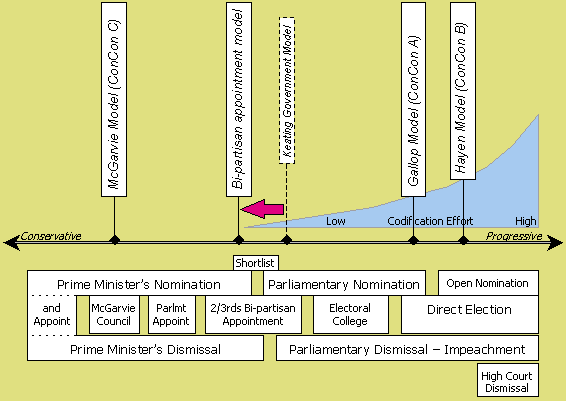
Above: Popular Republican Models compared on the Spectrum of Powers
The line itself is marked Conservative at one end and Progressive at the other, although these general terms should be preferably understood in the context of republican model building.
Five specific models are shown by the block diamond on the line. These are the four models voted upon at the Constitutional convention, plus the 1993 preferred Keating Government Model (also preferred by the ARM during those years). An arrow appears to indicate the change in ARM position between the time of the Republican Advisory Committee and the conclusion of the Constitutional Convention. It is likely that the most popular direct-election model of the convention – the Gallop Model, moved in a conservative direction while being developed there.
Below the line are the general features of the models. The organisation of these along the spectrum is meant as a guide. In the final analysis the decision as to whether a feature is more conservative or progressive is partly a question of opinion, partly a question of common sense. Furthermore there are anomalies, unavoidable as the further detail of each model is explained. The obvious example is the organisation of Prime Ministerial dismissal, for which the McGarvie Model is less conservative than the Bi-Partisan Appointment model.
Finally the diagram indicates that the codification effort for the more progressive models is greater for those holding the conservative positions. The triangle height is indicative of the effort and if more models appear on the progressive side of the spectrum, the codification effort, that is the legal powers, would be in need of some elaboration.
Other new models which appear (with the exception of the Honorary President Model of this submission) are likely to accept the contention that they are either conservative, progressive or somewhere between. The progressive models are likely to attempt a codification of the President’s powers such that the reserve powers of the Governor General are limited, eliminated or transferred.
Assessing Popularity Using the Spectrum
The Presidential Power Spectrum can be used to show the difficulty of obtaining success in the Parliament, which must agree to formulate the changes and success in the electorate, where a majority of electors in a majority of states must say yes in a referendum. Both the Parliament and the electorate have different conservative and progressive elements and this generally determines whether they, firstly, approve of any change and then, secondly, the type of republican models they have confidence in.
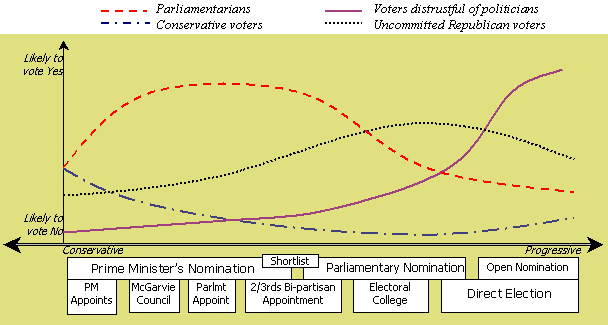
Above: Theoretical Support Curves along the Presidential Power Spectrum
In the diagram above a voting block of electors who hold certain beliefs about the move to a republic are tested against the conservative, moderate or progressive models on the spectrum. The test results appear as a support curve on the spectrum. Note that no polling has been used to create this submission, so the results presented are only theoretical. The parliamentarian group, who should have an well developed understanding of the political system, are inclined to vote for a moderately conservative model and adverse to the change and cost of direct election. Conservatives vote for conservative models but in some circumstances for conservative systems. A voter distrustful of politicians will reject involvement by parliamentarians even at the nominations stage while strongly supporting direct election. A republican voter, uncommitted to any model, could be supporting for all, but is most likely to support the more conservative of the direct-election models.
The spectrum projects the well understood idea that majority support from parliamentarians doesn’t always translate as electoral support sufficient to pass the test of a referendum.
The strategy for republicans, who are flexible in their support for a model, has been to find the centre then broaden the provisions outwards to accommodate the beliefs of republicans on both the conservative and progressive side of that position. This is why the ARM preferred model was to incorporate a nominations committee (a progressive concept) and prime ministerial dismissal (a conservative concept). These in turn were modified so that the nominations committee short-list was not binding on the Prime Minister (conservative) and a prime minister’s dismissal would be ratified by the Parliament within 30 days (progressive).
Although most discussion about models is about whether the provisions of a model are good or bad, advantageous or disadvantageous, popular or unpopular the underlying assumption behind the strategy is that support for a model is greatest in the middle. For republicans not committed to a particular model, finding the ideal compromise position is the key to success.
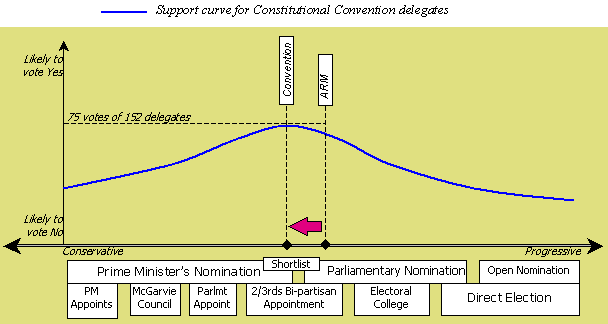
Above: Finding the Middle along the Presidential Power Spectrum
Supporters of the compromise strategy would accept the support curves described in the above diagram. It shows that at the convention the bi-partisan appointment model, introduced by ARM delegates to the Constitutional Convention, was moved to a slightly more conservative position through dialog with other delegates.
Further conservative movement would have reduced the total support for the model. An example of this was the Bishop amendment, which would have attracted slightly more support from conservative delegates but would have lost the support of even more progressive delegates.
Achieving compromise to produce a model with the highest possible support does not guarantee majority support and this did not happen the convention. What it does show is that no other model, not just the models voted upon and not even any hypothetical model that may have developed after further discussion or lobbying, in fact, no model whatsoever on the spectrum of power could have achieved higher support.
The Spectrum at the Referendum
The support curves for the referendum itself may not be read as simply. The success of the NO campaign has been largely attributed to its appeal to both conservatives and progressives. What does this say about the support curve that could be drawn for the national electorate?
In the diagram below there are two views of the electorate A and B.
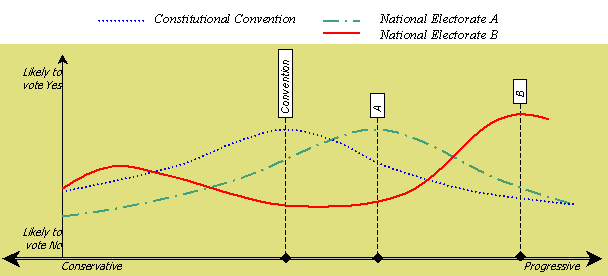
Above: Referendum perspectives along the Presidential Power Spectrum
The A support curve represents political common sense. It says that the range of views present at the convention was also present in the electorate. It says that the best strategy to win a referendum is to find the centre and then broaden the appeal of the proposal outwards. If the electorate is more progressive than the convention delegates, this is reflected by a progressive movement of the support curve. The result is model A – the best chance for a republic under these assumptions.
The B support curve represents a perspective of the electorate according to some advocates of direct-election. It is a purists view, proposing that the best chance of constitutional change cannot be achieved by mere compromise. Under this support curve, the weight of support is on the extremes and the best result is model B.
Although the A curve makes political common sense, the purist B curve is relevant in the case of a republican referendum. The centre position is inelegant, a compromise, difficult to grasp. In the mind of a disinterested elector, it could be the soup spoiled by too many cooks. Perhaps the elector does not really care about the power balance between the President and Prime Minister and more concerned with it being straightforward and/or decisive. It is the extremes of the spectrum that offer these qualities, not the centre which tries to be a bit of everything.
Part of the NO campaign strategy was to suggest to voters that they decline a republican constitution until the demand for a directly elected President was fulfilled. Given the success of this campaign, this could be evidence that the B curve could be a better indicator of the electorate than A.
Knowing if the electorate resembles either the A or B support curves can be used to indicate which types of models, along the spectrum, would be most likely to be successful at a referendum. If the political orthodoxy is right then the A curve suggests that the best model is a balance of conservative and progressive features, leading ultimately to a balance between the powers of the Prime Minister and President. And if B is correct, then it’s an intense battle between conservatives and progressives, one group proposing the minimalist alterations, the other proposing seemingly revolutionary changes.
Unfortunately, although this analysis may show which model on the spectrum of powers is most likely to pass the test of a referendum, it cannot show not whether it would finally pass.
Status Quo and the Spectrum
One of the common refrains from supporters of the status quo is that none of the proposed models for a republic is better than the present constitutional monarchy. Does the analysis using a spectrum of powers assist in understanding this opinion?
An obvious conclusion about the debate between the republican proposals is that it results in a tug-of-war between conservative and progressive republican advocates. When a conservative argument about maintaining the power of the Prime Minister is accepted, the model moves in the conservative direction. When the progressive idea of using a nominations committee becomes attractive, the model moves in a progressive direction.
This sort of debate cannot persist under the present system because the constitution says so little on this subject – only that the Governor General is appointed at the Queen’s pleasure.
The authority held by the Queen has no political basis in Australia. The appointment and dismissal procedures for the Queen are entirely outside the province of the Australian Prime Minister, Parliament and Courts. Governors-General, being representatives of the Queen, take their legitimacy from the Queen.
The history of the office is an example of the flexibility of the constitution in this regard. The first governors-general where appointed by the Imperial Government. In contract, modern times have seen appointments made from both political and apolitical figures. It is possible to imagine a more transparent appointment process for the future, however none of these developments has or would affect the political power of the Prime Minister.
In conclusion, the status quo is not a model that can be placed along the spectrum of powers.
The Republican Paradox
At the heart of the existing republican model debate is a paradox.
The model maker is expected to propose a system with qualities on either side of the spectrum of powers. The proposed President is not political, yet has survived an election process and substantial public scrutiny. The President should belong to the people, yet act only on the advice of the Prime Minister, except in the case of the most extraordinary constitutional crisis. We would expect that the President have the support of the people yet take no mandate from the people in carrying out his/her important albeit apolitical responsibilities.
The bi-partisan appointment model has been the first casualty of this paradox. From the conservative side it was attacked for weakening the constitutional conventions critical to our system of government. On the progressive side it was attacked for giving the Prime Minister and Parliament too much power.

Above: Contradictory Qualities of the Ideal Model
It is now generally accepted that this paradox is unresolvable. The ideal model has qualities that are inherently contradictory. According to popular republican sentiment, this is something that the rest of the electorate must simply learn and accept.
Plebiscite Solution
The most popular work-around for the paradox is to offer the electorate a plebiscite. The rationale for a plebiscite is that the results will unite republicans behind the most successful model. Once the debate on the model has been concluded, it is more likely that a referendum will succeed.
The ARM propose a number of models all of which appear on the spectrum of powers. In addition there is the McGarvie Model.
It is likely that no model will attract majority support in the plebiscite. This in itself may indicate that the most attractive model is unlikely to pass at a referendum, however the plebiscite solution assumes that republicans will agree to support the winning model in the interests of achieving the goal. Unfortunately, we would need to imagine that republicans supporting a McGarvie-like model would, after the plebiscite, realise that their objections to more progressive models were groundless. Alternatively, we could imagine that direct-election purists would abandon their deeply held democratic ideals and support an appointment system.
There is no evidence that this would happen. McGarvie Model supporters believe that the status quo is unequivocally better than directly-electing the President. As the referendum showed, direct-election purists would rather work with monarchists than accept parliamentary appointment.
Finally, it is likely that the support curve will move between the plebiscite and the referendum. The most attractive model in one year may be substantially different three years later, especially if a number of compromise provisions are included during the intervening period.
In conclusion, the plebiscite proposal is likely to affect only the margins of the republican model debate. The support advantage from winning the plebiscite may not translate into success at the referendum.
The Passionate Debate
There have always been calls for others to lay aside passion in the interests of resolving the republican model debate.
Centrists is an appropriate term for those republicans who supported the bi-partisan appointment model debate but actually are interested in supporting the compromise model with the best chance of winning a referendum. The primary goal for centrist republicans is full-independence for Australia from the monarchical institutions of Great Britain. It is only a secondary goal to provide a better constitution.
The Centrist perspective is strongly represented by the Australian Republican Movement. They are the leaders in the push to become a republic and without them the issue would be far more easily marginalised and confused with other issues such as citizen-initiated referenda or a bill of rights within the constitution.
The dialog of the Centrist perspective is moderate, polite, respectable and diligent. It is pleased to work with all the major political parties, understanding the importance of bi-partisanship.
Conservative republicans are less concerned with the primary goal of independence, but are more concerned that the constitution is not destabilised in the process. They may reject change for this reason and make their warnings public.
Progressive republicans are concerned with the primary goal of independence and a more democratic, accessible and transparent constitutional structure in equal measure. They see the centrist agenda as too limited. The republican push is also a chance to democratise the executive, to make it not just accountable to the Parliament, but to the people.
Both progressive and conservatives republicans attain prominence through the efforts of the centrists to raise the republican agenda. This is a source of friction as centrists feel they need to work twice as hard as necessary.
The passionate argument between these three types of republicans is strongly felt in the centre, yet it is internalised. The republican paradox is an enormous frustration, but ultimately without conservative support their proposals can be portrayed as destabilising our system of government. Without the support of progressive republicans, the proposal can be portrayed as undemocratic and compromised.
Three Unsuitable Solutions
The republican paradox exists because no model along the spectrum of powers can satisfy both the progressive and conservative sides of the debate.
To unlock the paradox, the model maker should begin to consider proposals that do not appear along the spectrum of powers. There are three known solutions to this problem.
The first solution is the status quo. The legitimacy of the Queen has no political basis and the Governor General borrows this apolitical authority.
The second solution is to codify the powers of the President, extinguishing the reserve powers. This leaves the President with legal powers and no political power. There are a small number of republican model which attempt to do this, but they involve a radical redrafting of the constitution.
The experience of politicians and political experts is that redrafting the constitution is extremely unlikely to win the favour of the electorate. There is almost no possibility that a majority of the people will consider a new system as safe, especially when the objective is to remove the Queen from our political system and when confidence in our constitution remains generally high.
The third solution is to fundamentally diminish the status and authority of the Prime Minister. This solution means, in effect, establishing an Executive Presidency, either within or external to the Parliament. A small group of direct-election republicans are in favour of such a solution, however the revolutionary changes required are generally regarded as unsaleable to the electorate.
The Current Stalemate
The paradox leaves the republican debate and republican movement stalemated.
Although the problems of the debate have not been previously described using the spectrum of powers paradigm, republicans are well aware of the problems in trying to move forward. The promotion of a national plebiscite is evidence of the belief that there are no real solutions.
The capacity of model makers to find republican models that do not appear along the spectrum of powers has been hampered by the original terms of reference for the Republic Advisory Committee. The fundamental assumption behind the models canvassed has been to remove the Queen and it doing so, promote the Governor General to President.
The advantage of the spectrum of powers paradigm is that it demonstrates that these fundamental assumptions can be revisited. In fact, they must be. The alternative is a republic which is less sensible, less reasonable and less practical than the status quo – a republic just scraping over the referendum line if at all.
A Fourth Solution
We have already uncovered three solutions to the spectrum of powers. The first is to maintain the status quo and this solution was refected in the results of the 1999 referendum. The second solution is the codification of all the powers of the President. The third is an executive President. As discussed, while these resolve the paradox, more problems are created than are solved. In the case of the status quo, nothing changes.
The fourth solution is to revisit the fundamental assumptions that to remove the Queen, that her powers must be combined with those of the Governor General and offered to the President. A new alternative is to replace the Queen with a President and leave the position of the Governor General unaltered.
The Honorary President Republican Model uses this alternative method of establishing an Australian republic. The term President is qualified as Honorary President to demonstrate the position is not executive, but ceremonial .The main tenants of the model are:
- The Honorary President is directly elected
- Some nominations are accepted through public petition
- Some nominations are made by state and federal parliaments
- The appointment (and dismissal) of the Governor General is the same as the status quo, except the appointment is made by the Honorary President
The model cannot be placed on the spectrum of powers in just one position. Existing models establish or alter one position, yet this model establishes or alters two. Let this be called the duel aspects of the model. The consequence is that the model sits in more than one place on the spectrum of powers.
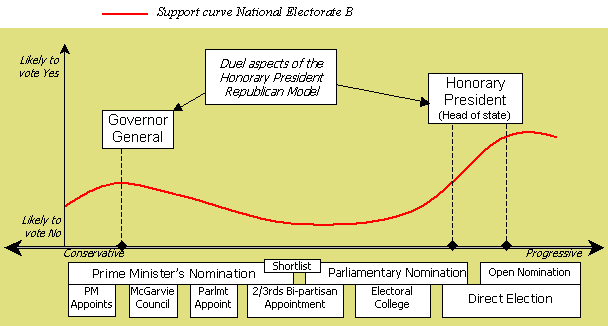
Above: The Honorary President Republican Model
The Governor General on the conservative side of the line holds the first position. They are nominated by the Prime Minister but are appointed by the Honorary President. The function of the Honorary President is equivalent to McGarvie’s Constitutional Council in terms of its conservative appeal.
The other positions are held by the Honorary President on the progressive side. Two positions are shown to indicate that candidates for election are accepted via two methods – public petition and parliamentary nomination. The former method should have the greater support.
After introducing support curve B (discussed earlier) we can see that the Honorary President Republican Model sits in an interesting position. It appears to take advantage of support from either end of the spectrum of powers. Although we must factor in a reduction of support from voters who cannot or will not break their republican assumptions, the position of the model appears to be favourable in terms of overall support.
The conclusion of this essay is that the Honorary President Republican Model could be a highly popular model in the eyes of the electorate. It could accede to the wishes of those progressive voters who desire a popularly elected Head of State, without objection from conservative voters concerned that such an election would destabilise our existing system of government.